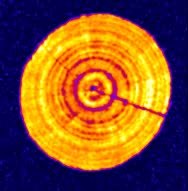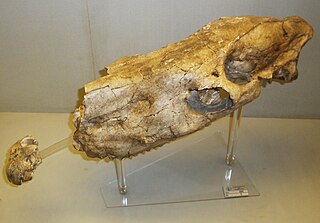
Allopleuron is a genus of extinct sea turtle, which measured 2-to-2.5-metre long in life. The type species is Allopleuron hofmanni. It is a basal member of the clade Pancheloniidae, closely related to Protosphargis. Similar to Protosphargis, it was characterized by shell reduction.

Arietites is a genus of massive, giant evolute, psiloceratacean ammonites in the family Arietitidae in which whorls are subquadrate and transversely ribbed and low keels in triplicate, separated by a pair of longitudinal grooves, run along the venter. Fossils are known world wide from the lower Sinemurian stage of the Lower Jurassic. Safari Ltd made an Arietites bucklandi figurine in 2014.

Simolestes is an extinct pliosaurid genus that lived in the Middle to Late Jurassic. The type specimen, BMNH R. 3319 is an almost complete but crushed skeleton diagnostic to Simolestes vorax, dating back to the Callovian of the Oxford Clay formation, England. The genus might also be known from the Tithonian Bhuj Formation of India (S.indicus), however the referral of this species to Simolestes is dubious. S.keileni from France was moved to the new genus Lorrainosaurus in 2023.
Bactritimimus is a genus of belemnite from the Mississippian Epoch.

Belemnopsis is a genus of belemnite, an extinct group of cephalopods.
Conoteuthis is a genus of belemnite, an extinct group of cephalopods.
Diplobelus is a genus of belemnite, an extinct group of cephalopods.
Gonioteuthis is a genus of belemnite, an extinct group of cephalopods. It grew to a body length of 8 inches and fed on small marine animals. Fossils of Gonioteuthis have been found in the Netherlands, Germany, and Sweden in rocks dated to the late Cretaceous Period, specifically 85 to 70 million years ago.

Neohibolites is a genus of belemnite, an extinct group of cephalopods.

Passaloteuthis is a genus of belemnite, an extinct group of cephalopods. Belemnites are typically known for having about 40 micro-hooks on each one of its appendage. However, Passaloteuthis is notable for being associated with a pair of mega-hooks known as onychites. These hooks are tentatively interpreted as male-specific features, though their exact function is still unknown.

Youngibelus is a genus of belemnite, an extinct group of cephalopods.

Belemnites is a genus of an extinct group of cephalopods belonging to the order Belemnitida. These cephalopods existed in the Early Jurassic period from the Hettangian age to the Toarcian age (175.6–183.0). They were fast-moving nektonic carnivores.

Eurygnathohippus is an extinct genus of hipparionine horse. The majority of known fossils of members of this genus were discovered in Africa, where members of this genus lived during the late Miocene to Pleistocene interval. Fossils of Eurygnathohippus were also reported from the late Pliocene sediments of the Potwar Plateau in Pakistan and the Siwalik Hills in northwest India.
The Chouteau Limestone is a geologic formation in Illinois, Iowa, Kansas, and Missouri. It preserves fossils dating back to the Carboniferous period.

The Peedee Formation is a geologic formation in North and South Carolina. A marine deposit, named for exposures along the Great Peedee River, it preserves belemnites and foraminifera fossils dating to the Late Cretaceous (Maastrichtian). The formation is notable for its occurrence of Belemnitella americana, known as the Pee Dee Belemnite (PDB), a long-standing standard in stable carbon isotope research. A single pterosaur femur, possibly an Azhdarchid, from the Peedee formation is one of the few pterosaur body fossils found in Eastern North America.
The Staffin Bay Formation is a geologic formation in Scotland. It preserves fossils dating back to the Callovian of the Middle Jurassic. It consists of two members, the lower Upper Ostrea Member, which consists of dark grey, fissile mudstone with a shelly limestone bed, and laminated and rippled sandstones. While the upper Belemnite Sands Member consists of medium-grained calcareous sandstones and siltstones
The Calcaire à Bélemnites is a geologic formation in France. It preserves fossils dating back to the Jurassic period.
Distomodus is an extinct genus of conodonts.

Boreostemma is an extinct genus of glyptodonts from northern South America. Fossils assigned to the genus were first described as belonging to Asterostemma from southern South America, but have been placed in the new genus Boreostemma by Carlini et al. in 2008. The type species is B. pliocena. Fossils of Boreostemma have been found in the Honda Group of Colombia, in Peru and Venezuela.
The Köpinge Sandstone is a highly calcareous and glauconitic sandstone geologic formation of the Vomb Trough in Skåne, southernmost Sweden. The formation dates to the latest early to middle late Campanian stage of the Late Cretaceous and has provided fossils of ammonites, belemnites, the shark Cretalamna borealis and the mosasaurid Hainosaurus. Ex situ occurrences in Pleistocene deposits have provided a dorsal vertebra of a possible elasmosaurid.











